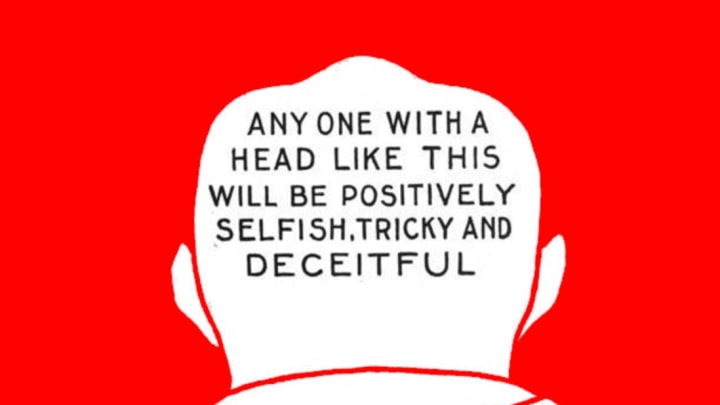Meet Louis Allen Vaught. He was born in 1859, and his masterpiece, Vaught's Practical Character Reader, was self-published in 1902. The physical address of his “publishing company” was also, according to these advertisements, home to the dubious sounding Human Science School and the Chicago Institute of Phrenology.
Vaught was a physiognomist. Physiognomy had been a “science” since ancient Greece, and it waxed and waned in popularity over the millennia until the 20th century. Those who believed in it sought to sum up the soul and strengths of a person simply by looking at their physical characteristics—to apply structure to the natural instinct to judge on appearance, which humans have always done and likely will always do. (The slope of a brow suggests criminal inclinations, the cut of your nose indicates your suitability as a good accountant.) Vaught identified around 40 “Elements of Human Nature,” such as suavity, alimentiveness, and approbativeness. To each of these Elements, there is a corresponding head or facial feature.
Eventually, physiognomy became closely aligned with phrenology (the same concept, instead using only skull bumps), which was discredited in the 20th century. Though there are instances of revival, most people today put little stock in the shape of a person’s ear cartilage reflecting the shape of their spirits.
Vaught’s illustrations show that he subscribed to the “Bugs Bunny” philosophy of criminality. His sample subjects look somehow incomplete without a raccoon mask and a bag with a dollar sign printed on it. However, if you are able to imagine these cartoon characteristics as actual human ones, you might learn a lot about your community. Maybe even about yourself! Let’s find out just how evil your head is.
1. Tricky and Deceitful

The first lesson. Never trust a bald, pointy-headed 1930s gangster with Spock ears. That fellow is trouble.
2. About Face

Where phrenology focuses only on the variances in skull bumps to read character, Vaught’s “research” allowed him to add facial features to the list.
3. One Bad Mother

The inferiority of this woman as a mother is indicated by her concave “backhead.” This is the center of mother-love, and it bulges in a true mother.
4. Young Ladies, Beware!

This man’s head shows signs of an overly large Amativeness (sexual desire) region. He also appears to have a dishonest nose and a chin severely lacking in constancy.
5. Case Study

The arrows indicate the proof of Vaught’s theories. Says Vaught, “Robert Louis Stevenson's talent was of the order of genius. He could not have produced Dr. Jekyll and Mr. Hyde without a great development of the faculties of Form and Comparison. In a study of his head we were struck with the very great development of his faculty of Form.”
6. Constitutional Laziness

“Genuine laziness is the result of deficient Destructiveness, Combativeness, Approbativeness, Acquisitiveness, Self-esteem, Firmness and Conscientiousness. No one really likes hard work of any kind who is weak in the faculties of Destructiveness and Combativeness.” Maybe so, but I bet this guy knows all the lines from The Big Lebowski by heart. I’d hang with him.
7. The Nose Knows

The husband is drawn with a touch more fear in his eyes than the wife. The Hope Element on this skull could use some thumping.
8. Man is Matter

Existential Crisis? It’s your engorged Alimentiveness and Amativeness Faculties.
9. The Source of Corns

This passage I thought really encapsulated Vaught’s theories and teaching style. That is to say, it’s easy to imagine the first draft of this book having been scrawled on an asylum cell wall with broken crayons. But we laugh only from the safe vantage of the future. In 100 years the DSM-5 might look like it was cobbled together by lunatics in celebration of themselves. And for that matter, I don’t believe any of the DSMs have ever been kind enough to try and decipher bunions, as the good Mr. Vaught has done for us. Thank you, Mr. Vaught. Science marches on.
